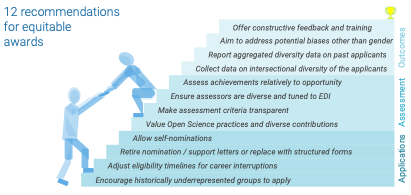Research awards for early and mid-career scientists have lots of room for improvement
Published in Ecology & Evolution

The “school story”
A few years ago, I attended a graduation ceremony at a local primary school. I sat through the speeches, performances and all the things that usually happen at such events. No such event is complete (at least in this school) without student awards. And it was just great to see the diverse school student population showered with prizes ranging from arts, leadership, sports, and, of course, academic achievement.
However, prizes for top achievers in individual school subjects stood out for one particular reason. I noted immediately that all awards for subjects like English, history, geography went to girls, while awards for math and science went to boys. Was this surprising? And does this matter?
In our earlier paper in Nature Communications (O'Dea et al. 2018 and to its "behind the paper" blog), we compared distributions of school grades of boys and girls across different subjects. Girls’ performance was clearly better and less variable in non-STEM subjects and very similar to boys in STEM subjects (STEM stands for Science Technology Engineering and Mathematics). If performance of both genders in STEM is usually similar, why would boys get all the STEM awards at school?
I can only speculate for this specific school, which is, by the way, very inclusive and progressive. Maybe they did not want the majority of the awards go to girls, so they thought it would be most “natural“ to give the STEM awards to boys. Whatever the reason, to me it looked like “humanities for girls, STEM for boys” case, reinforcing stereotypes, and ultimately harmful for women in science.
The “academia story”
There is a general lack of diversity in senior and leadership positions in STEM. The most visible gap, and the most widely discussed on, is the paucity of women. However, it is worth noting that the gaps and biases exist also for other characteristics, such as race/ethnicity, mother tongue, caring responsibilities, social class, wealth or educational backgrounds – unfortunately, they are much harder to assess and thus also less publicised.
The most striking example of gender imbalance relates to Nobel prizes. Among the Nobel prize winners in physics, chemistry, physiology and medicine, only 23 (out of over 600 medals awarded between 1901-2021), went to female laureates (Sanderson 2021). Lack of women in Nobel prizes is just a pinnacle of similar patterns found across prestigious scientific awards (Watson 2021). Why women are less likely than men to enter the pool of potential nominees for the top-ranked awards?
There is no one simple answer to this complex question. Potential answers include existence of explicit and implicit biases, structural barriers, and much more. Particularly, the so-called “Matthew effect” could be a contributing large-scale mechanism. The Matthew effect is a fancy name for the cumulative nature of advantage (and also disadvantage), where a small initial (dis)advantage snowballs into a large (dis)advantage over time (Jebsen et al. 2022).
In the context of research awards, receiving accolades and prizes for your scientific work early on can set you up for later success by opening doors to research networks, funding, jobs, and also further awards. Then, it is utterly critical to know do existing awards available at early career stages provide a level playing field for historically marginalised groups, including women? What is valued in research assessments for existing awards? Also, what are the historical trends in gender representation among the prize winners?
To answer these questions, we looked at the two types of awards given to early and mid-career researchers in ecology and evolution (Lagisz et al. 2023). With a diverse team of co-authors, I found that very few awards explicitly encourage historically underrepresented groups to apply or provide detailed descriptions of how the candidates and their work are assessed. For the “best paper” awards (given for a single published work) it is common to allow self-nominations at the time of manuscript submission. In contrast, for “best researcher” awards (given for overall achievements or multiple works), nominations often have to be made by another person and include supporting letters, which might disadvantage some of the potential candidates (Skibba 2016), especially the ones lacking support from senior researchers or self-confidence, turning them away from applying.
Further, the award descriptions are generally very vague and only in one case explicitly referred to open and transparent research practices as something that is being valued in research assessment, rather than striking or novel results. Finally, in the last ten years, the gender gap closed for most of the awards we studied. Unfortunately, we have no information on the winners diversity in other than gender dimensions, which are much harder to assess when you only have access to awardee names and affiliations.
People behind the project
Critical for this project was the fact that I worked with a very diverse team. I invited a few former lab members and a few new collaborators, ensuring a good mix of different backgrounds and experiences. My co-authors not only helped me with data collection but also contributed insightful and valuable perspectives for the interpretation of our results and collating recommendations. We hope that these recommendations could help in lowering barriers for historically marginalized groups when it comes to applying for awards and providing fair assessments.
Open Awards
While many of the recommendations listed in the figure below were already proposed by other authors from other disciplines, we added one, seldom mentioned in this context. We see the research awards as an opportunity to promote and incentivise Open Science practices, such as project registrations, open data and code sharing. Explicitly valuing robustness and reproducibility (e.g., via sharing data and code), along with improving transparency of the awards themselves, can change the research culture. To many, Open Science is also about being open and supportive to the participation of historically underrepresented groups.

Back to where it started and forward
A few months ago, I attended another graduation ceremony at the same local primary school. Nothing has changed there: girls got all the non-STEM awards, and boys got the STEM ones. While I do not have much influence on how prizes are given there, I do hope that our work on research awards in academia will spearhead some change for the young researchers in ecology and evolution, and maybe even beyond.
Follow the Topic
-
Nature Ecology & Evolution

This journal is interested in the full spectrum of ecological and evolutionary biology, encompassing approaches at the molecular, organismal, population, community and ecosystem levels, as well as relevant parts of the social sciences.
Related Collections
With Collections, you can get published faster and increase your visibility.
Understanding species redistributions under global climate change
Publishing Model: Hybrid
Deadline: Jun 30, 2026






Please sign in or register for FREE
If you are a registered user on Research Communities by Springer Nature, please sign in